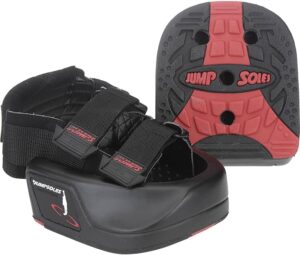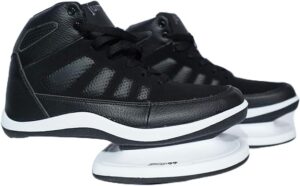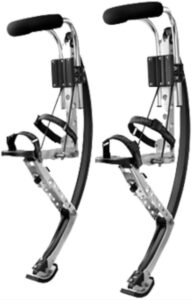Are you looking to take your athletic performance to new heights? Do you want to soar higher, run faster, and push your limits beyond what you thought possible? Look no further than jump shoes – the secret weapon of athletes seeking to elevate their game.
In this comprehensive guide, we’ll dive into everything you need to know about jump shoes, from how they work to choosing the right pair for your needs and incorporating them into your training regimen. Let’s lace up and jump into the world of jump shoes!
Introduction to Jump Shoes:
Jump shoes, also known as bounce shoes or spring-loaded shoes, are specialized footwear designed to enhance your vertical jump and overall athletic performance. Jump shoes, combined with workouts or other exercises can provide your legs and feet the training they need to jump higher for basketball dunks, jump higher for volleyball spikes, or get more extension for tennis overhead smashes. By utilizing built-in springs or platforms, these shoes provide added propulsion and energy return, allowing you to generate explosive power with each step or jump.
Benefits of Jump Shoes:
The benefits of incorporating jump shoes into your training routine are numerous:
- Increased vertical jump height, essential for sports like basketball, volleyball, and track and field.
- Enhanced speed and agility, enabling you to outmaneuver opponents on the field or court.
- Improved strength and conditioning, as jump shoes engage key muscle groups in your legs and core.
- Reduced risk of injury, thanks to the cushioning and support provided by these specialized shoes.
Types of Jump Shoes:
There are several types of jump shoes available, each with its unique features and advantages:
Jumping Stilts:
They consist of a metal frame attached to a person’s lower legs, with a foot platform at the bottom and a spring mechanism connecting the frame to the foot platform. The user wears special boots or shoes that attach securely to the foot platform.
The spring mechanism in jumping stilts works similarly to that of spring-loaded shoes, providing additional propulsion and energy return when the user jumps or strides. However, jumping stilts are distinct from spring-loaded shoes in several ways:
Jumping Stilts Design:
Jumping stilts have a more elaborate design, with a larger spring mechanism and a longer frame that extends from the user’s lower legs. This design allows for greater flexibility and range of motion compared to spring-loaded shoes.
Height: Jumping stilts can provide significantly higher vertical jumps compared to spring-loaded shoes, often allowing users to achieve heights of several feet above the ground.
Purpose: While both jumping stilts and spring-loaded shoes are designed to enhance jumping ability, jumping stilts are typically used for acrobatics, stunts, and extreme sports such as powerbocking and free jumping. They are popular among performers, athletes, and enthusiasts looking to perform aerial tricks and maneuvers.
Learning Curve: Jumping stilts require more skill and balance to use effectively compared to spring-loaded shoes. Users must undergo proper training and practice to master the techniques required for safe and successful jumping.
Spring Loaded:
Spring-loaded jump shoes possess several unique features and advantages that set them apart from traditional athletic footwear. Here are some key characteristics:
Spring Mechanism: The defining feature of spring-loaded jump shoes is their built-in spring mechanism. Typically located in the sole or heel of the shoe, this mechanism absorbs impact and stores energy when the wearer lands or compresses the spring, which is then released during the subsequent jump, providing added propulsion and lift.
Energy Return: The spring mechanism in jump shoes enables efficient energy return, allowing users to bounce higher and propel themselves forward with less effort. This feature can significantly enhance vertical jump height and overall athletic performance.
Shock Absorption: In addition to enhancing propulsion, the spring mechanism in jump shoes serves as a form of shock absorption, reducing the impact on joints, muscles, and ligaments during high-impact activities such as jumping, running, and landing. This can help prevent injuries and alleviate stress on the body, particularly in activities that involve repetitive pounding on hard surfaces.
Versatility: Spring-loaded jump shoes are versatile and can be used for a variety of activities, including fitness workouts, sports training, recreational jumping, and even dance routines. They are suitable for individuals of all fitness levels and ages, offering a fun and effective way to stay active and improve cardiovascular health, strength, and agility.
Engagement of Muscles: Jump shoes engage a wide range of muscles throughout the body, including those in the legs, core, and stabilizing muscles. This comprehensive muscle activation can lead to improved strength, endurance, and muscle tone over time, making them a valuable tool for overall fitness and conditioning.
Low-Impact Exercise: Despite their ability to generate high levels of force and power, spring-loaded jump shoes provide a relatively low-impact form of exercise. The cushioning and shock-absorbing properties of the spring mechanism help reduce the strain on joints and minimize the risk of overuse injuries, making them suitable for individuals with joint issues or those recovering from injuries.
Fun and Novelty: Beyond their functional benefits, spring-loaded jump shoes offer a unique and exhilarating experience that appeals to users seeking a fun and novel way to exercise and challenge themselves. The sensation of bouncing and flying through the air can be both thrilling and addictive, motivating users to stay active and engaged in their workouts.
An example of Spring Loaded Jump Shoes is Kangaroo Jumps: Kangaroo Jumping Boots are designed to soften the impact of plyometric exercise while still providing the fun that these types of exercises offer. Kangaroo jumps are also used for the rehabilitation of sports injuries. When looking at the shoes and the platform that they reside on, the built-in cushioning is readily apparent. 
Spring-loaded jump shoes provide a combination of performance-enhancing features, injury-preventing properties, and entertainment value that make them a popular choice among fitness enthusiasts, athletes, and individuals looking to add an exciting dimension to their exercise routine.
Platform Shoes:
Platform shoes utilize elevated platforms to enhance vertical jump height. An example of these would be JumpSoles.
These are small, trampoline-like platforms that attach to your regular shoes. These jump shoes have secure velcro fasteners that fit across the front forefoot and heel for a secure fit. The jumpsoles are touted to help leg muscles become more accustomed to fast movements, which in turn helps increase your jump height. These shoes also come with a training program to help you make the most of what these shoes have to offer to help you jump higher and move off the line faster.
Another example of platform shoes is the Jump 99 Plyometric shoes. These are designed to enhance vertical jump performance and overall athletic ability.

Design: Jump99 training shoes feature a unique design with an elevated platform sole that adds height to the wearer’s heels. The elevated sole creates a biomechanical advantage, allowing for greater ground clearance and improved leverage during jumps.
Plyometric Training: These shoes are specifically designed for plyometric exercises, which involve rapid, explosive movements such as jumping, bounding, and hopping. Plyometric training aims to improve the efficiency of muscle contractions, enhance power output, and increase vertical jump height.
Spring-loaded Sole: Jump99 training shoes utilize a spring-loaded sole or cushioning system to provide additional support and energy return during plyometric movements. The spring mechanism absorbs impact upon landing and releases stored energy during the subsequent takeoff, aiding in propulsion and lift.
Ankle Support: Jump99 training shoes often feature a high-top design or additional ankle support to stabilize the ankle joint during dynamic movements. This helps reduce the risk of injury and improves proprioception, allowing for better control and balance during jumps.
Lightweight Construction: Despite their elevated platform and spring-loaded sole, Jump99 training shoes are typically lightweight and flexible, allowing for natural foot movement and agility. This lightweight construction minimizes excess bulk and facilitates quick, explosive movements during plyometric exercises.
Versatility: While Jump99 training shoes are primarily designed for plyometric training, they can also be used for other athletic activities such as basketball, volleyball, and track and field. Their versatile design makes them suitable for a wide range of sports and training routines.
Training Program: Jump99 training shoes are often sold as part of a complete plyometric training program, which may include instructional videos, workout routines, and training tips. This comprehensive approach helps users maximize the benefits of plyometric training and achieve their vertical jump goals more effectively.
Jump99 training shoes offer a specialized solution for athletes and fitness enthusiasts looking to improve their vertical jump height, power, and explosiveness through plyometric training
Which Jump Shoes are the best for you?
When deciding which Jump Shoes to purchase, the decision boils down to comfort and budget. If you are used to performing plyometric exercises and are looking to develop more explosive movements to enhance your sports performance and budget is not a concern then platform Plyometric shoes would be ideal. If this situation fits you, but budget is a concern, a pair of jumpsoles may be the better choice. Whichever pair you decide to choose is likely to provide a shoe-wearing experience that will forever give you a new shoe-wearing perspective.



